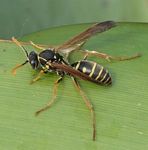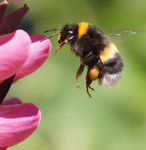Controlling Pest Insect Invaders - EVERYONE'S RESPONSIBILITY - Tasman District Council
←
→
Page content transcription
If your browser does not render page correctly, please read the page content below
Pest Insect Invaders
There are no longer pest insects listed in the
Tasman-Nelson Regional Pest Management
Plan, however we often receive requests on how
to control them, so this booklet is to assist you
in identifying and managing any insect pest
infestations you may have.
ARGENTINE ANTS – Linepithema humile
Argentina
Origin – First recorded as established in 1990 at Auckland. They accidentally
arrived at Port Nelson, and were discovered in 2001.
Characteristics – No acetic smell when crushed. Tiny, light brown in colour.
Form large super colonies. Form long continuous trails along edging and fences etc.
Management issues – Argentine ants are transported on vehicles and in freight,
rubbish and pot plants. These ants can have an impact on native fauna ecosystems.
Control methods – Poison: Surface contact spray, with Bifenthrin (avoid food
preparation areas). See back page for insecticide brands and availability.
DARWIN’S ANTS – Doleromyrma darwiniana
Australia
Origin – First recorded as nesting in Penrose, Auckland in 1959. A probable
separate establishment at Lyttelton in 1979. They were discovered in the 1980’s at
Nayland, Nelson, before Argentine ants arrived in Nelson city.
Characteristics – Acetic smell when crushed. Tiny, light brown in colour.
Management issues – Transported on vehicles and in freight, rubbish and pot plants.
Control methods – Poison: Surface contact spray, with Bifenthrin (avoid food
preparation areas). See back page for insecticide brands and availability.
2.WHITE-FOOTED HOUSE ANT – Technomyrmex jocosus
Australia
Origin – First discovered in New Zealand, at Nelson in 1921.
Characteristics – Black in colour and named ‘white-footed’ as they have white to
yellowish leg extremities. Commonly trailing on and in houses during summer.
They have a winged life stage.
Management issues – Nuisance value on and in homes.
Control methods – Poison: Surface contact spray, with Bifenthrin (avoid food
preparation areas). See back page for insecticide brands and availability.
BROWN MARMARATED STINK BUG – Halyomorpha halys
Asia
Origin – Currently not located in New Zealand.
Characteristics – When crushed they emit a characteristic, unpleasant and long
lasting odour. Adults are approx. 1.7 cm long with a distinctive brown “shield” shape.
Management issues – They are a devastating insect, potentially of plague
proportions, that will seriously damage our horticulture, viticulture, vegetable and
stock feed industries. Occasionally they are detected at New Zealand’s ports of
arrival, where thorough border inspections are in place to detect them. They may
arrive in import containers, luggage, the mail or on the transport of personal effects
and homewares.
Notifiable organism – A serious potential pest. Please contact the MPI hotline
0800 80 99 66 (Ministry of Primary Industries).
3.Two types of wasp nests
Vespula wasp nest (enclosed) Paper wasp nest (open)
ASIAN PAPER WASP – Polistes chinensis
Asia
Origin – Accidently introduced in St Helliers, Auckland around 1979. By 1990 it had
established in Nelson.
Characteristics – Small colony, on a small wood fibred, lantern shaped nest.
Management issues – Nests attached to buildings, particularly residential
buildings.
Control methods – Poison: Puff nest with powdered Permetherin or Allethrin &
d-Phenothrin. See back page for insecticide brands and availability.
EUROPEAN PAPER WASP – Polistes dominula
Europe
Origin – The comparatively recent accidental arrival was first discovered in
Waikawa/Picton in 2011. It’s now present in Nelson, Richmond, Motueka and
Golden Bay.
Characteristics – Looks very similar to the Asian Paper Wasp but has two tiny yellow
dots on top of the thorax. Small colony, on a small wood fibred lantern shaped nest.
Sometimes nests are built inside metal cavities, such as tubular metal framing.
Management issues – Nests attached to buildings, particularly residential
buildings.
Control methods – Poison: Puff nest with powdered Permetherin or Allethrin &
d-Phenothrin. See back page for insecticide brands and availability.
4.COMMON WASP – Vespula vulgaris
Europe
Origin – Accidentally introduced to New Zealand in the 1920s, when the first nest
was found here. It did not establish here until the late 1970s.
Characteristics – No black dots on the abdomen. Nests are “brown” in colour.
Colonies are large. Wood fibred nests are constructed inside rooves, with access
under corrugated iron edging, at gutterings. Also commonly located in banks and
at the base of flax/grass clumps.
Management issues – General nuisance with outdoor activities during peak
wasp numbers during March to April. Seriously affect native forest ecosystems, with
plagues of wasps destroying insects and nectar sources. Some people may have an
allergic reaction to wasp stings.
Control methods – Poison: Puff nest entrance with powdered Permetherin or
Allethrin & d-Phenothrin. See back page for insecticide brands and availability.
GERMAN WASP – Vespula germanica
Europe
Origin – The original incursion was the accidental arrival inside crates of aircraft
spare parts, in 1945 at Hamilton.
Characteristics – A series of two opposite black dots on each band of the
abdomen. Nests are “grey” in colour. Colonies are large. Wood fibred nests are
constructed inside rooves, with access obtained under corrugated iron edging, at
gutterings. Also commonly located in banks and at the base of flax/grass clumps.
Management issues – General nuisance with outdoor activities during peak
wasp numbers during March to April. Seriously affect native forest ecosystems, with
plagues of wasps destroying insects and nectar sources. Some people may have an
allergic reaction to wasp stings.
Control methods – Poison: Puff nest entrance with powdered Permetherin or
Allethrin & d-Phenothrin. See back page for insecticide brands and availability.
5.BUMBLE BEE – Bombus species
Europe
Origin – Introduced from England in 1885 to help pollinate red clover.
Characteristics – Nests are normally in the ground, with 200 to 300 bees in a nest.
They have longer tongues to assist flower fertilisation. They are attracted to the
colour blue and are not aggressive.
Management issues – Their colonies are smaller in numbers than honey bees.
They are of high value for fertilising flowers, and are used commercially to fertilise
glasshouse crops.
Control methods – Considering their low numbers, docile nature, minimum
nuisance and importance to fertilising flowering plants, try to live with them.
HONEY BEE – Apis mellifera
Europe
Honey bees are productive insects that provide honey. Occasionally they swarm and may set up
new hives on or in objects, on your residential property.
Origin – Originally introduced to Northland from Australia by Samuel Marsden
in 1839.
Characteristics – During November colony queens, may take their whole colony
to a new site. This is called swarming. Can sting only once.
Management issues – If swarming bees land on structures on your property
contact a local beekeeper, as they are always interested in reclaiming a hive.
Under the local RMA rules for residential zoned properties, up to two
beehives maybe kept on residential properties.
6.GISBORNE COCKROACH – Drymaplaneta semivitta
Western Australia
Origin – Common in timber arriving from Western Australia. First seen in Gisborne
in the 1960s, but now found from Auckland to Nelson. Present throughout Nelson
City, Richmond, Māpua and Motueka.
Characteristics – Fawn strips on the outer shell of the thorax. Scuttle off rapidly if
disturbed. Are seen at night time, on walls outside or in buildings. They can fit into
tiny confined spaces such as recesses in aluminium joinery.
Management issues – Can enter houses, but prefer to live outside.
They can populate to plague proportions if not controlled.
Control methods – Poison: Surface contact spray, with Bifenthrin (avoid food
preparation areas). See back page for insecticide brands and availability.
7.Disclaimer Helpful websites featuring
As a result of information in this booklet regarding insecticides and pest insects
insecticides, the Tasman District and Nelson City
Kiwicare – www.kiwicare.co.nz
Councils do not accept liability for any damage to any
person, property or thing that may arise from use of Pestrol – www.pestrol.co.nz
insecticides. Mention of product trade names implies
neither endorsement of those products nor criticism, Key Industries – www.nopests.co.nz
of similar products not mentioned.
Manaaki Whenua Landcare Research –
www.landcareresearch.co.nz/science/plants-animals-
Insecticides notes – Always fungi/animals/invertibrates
read label instructions!
Allethrin & d-Phenothrin – Brand names: Notification
Bayer Blitzem Wasp Killer & Nest Destroyer,
If you see any unusual insects, please contact the
KIWICARE® No Wasps Nest Killer
MPI hotline 0800 80 99 66.
Fipronil – Brand names: Key Industries KAS Ant Sand,
Vanquish Pro Ant Bait, VESPEX®
Registered pest controllers
Bifenthrin – Brand names: NoPests® X-It-Ant,
NoPests® Crawling Insect Spray, NoPests® Biforce If you are not prepared to control pest insects
Granules yourself, you can pay a pest controller to do the work
for you. Look at “PEST CONTROL” online or in the
Indoxacarb – Brand names: NoPests® Wasp Bait Yellow Pages of the phone directory.
Permethrin – Brand names: Bayer Blitzem Wasp
& Ant Nest Destroyer Dust, KIWICARE® No Wasps Pest insect control advice
Eliminator, KIWICARE® No Ants
If you would like further information on how to
Deltramethrim – Brand names: NoPests® Bug Spray control a pest insect issue, please contact your local
Biosecurity Officer through your local Council office.
Insecticides – These are available at farm supply
businesses, hardware stores and online from the
following supplier websites
20704 HotHouse Creative
Printed: 05/21
Richmond Murchison Motueka Tākaka
189 Queen Street 92 Fairfax Street 7 Hickmott Place 78 Commercial Street
Tasman District Council Private Bag 4 Murchison 7007 PO Box 123 PO Box 74
Richmond 7050 New Zealand Motueka 7143 Tākaka 7142
Email info@tasman.govt.nz New Zealand Phone 03 523 1013 New Zealand New Zealand
Website www.tasman.govt.nz Phone 03 543 8400 Phone 03 528 2022 Phone 03 525 0020
8. 24 hour assistanceYou can also read



























































